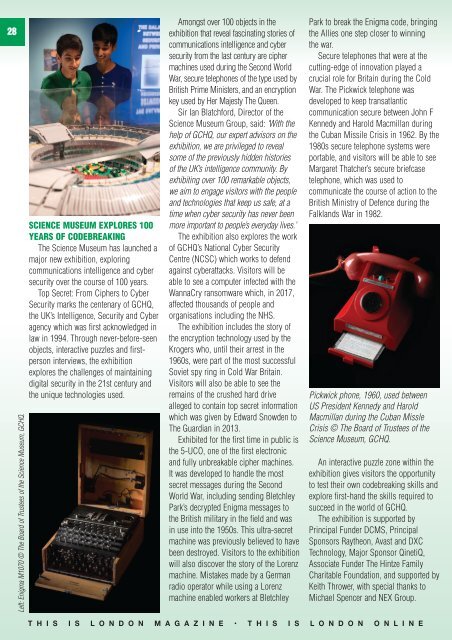This Is London Summer 2019
- No tags were found...
Create successful ePaper yourself
Turn your PDF publications into a flip-book with our unique Google optimized e-Paper software.
28<br />
Left: Enigma M1070 © The Board of Trustees of the Science Museum, GCHQ.<br />
SCIENCE MUSEUM EXPLORES 100<br />
YEARS OF CODEBREAKING<br />
The Science Museum has launched a<br />
major new exhibition, exploring<br />
communications intelligence and cyber<br />
security over the course of 100 years.<br />
Top Secret: From Ciphers to Cyber<br />
Security marks the centenary of GCHQ,<br />
the UK’s Intelligence, Security and Cyber<br />
agency which was first acknowledged in<br />
law in 1994. Through never-before-seen<br />
objects, interactive puzzles and firstperson<br />
interviews, the exhibition<br />
explores the challenges of maintaining<br />
digital security in the 21st century and<br />
the unique technologies used.<br />
Amongst over 100 objects in the<br />
exhibition that reveal fascinating stories of<br />
communications intelligence and cyber<br />
security from the last century are cipher<br />
machines used during the Second World<br />
War, secure telephones of the type used by<br />
British Prime Ministers, and an encryption<br />
key used by Her Majesty The Queen.<br />
Sir Ian Blatchford, Director of the<br />
Science Museum Group, said: ‘With the<br />
help of GCHQ, our expert advisors on the<br />
exhibition, we are privileged to reveal<br />
some of the previously hidden histories<br />
of the UK’s intelligence community. By<br />
exhibiting over 100 remarkable objects,<br />
we aim to engage visitors with the people<br />
and technologies that keep us safe, at a<br />
time when cyber security has never been<br />
more important to people’s everyday lives.’<br />
The exhibition also explores the work<br />
of GCHQ’s National Cyber Security<br />
Centre (NCSC) which works to defend<br />
against cyberattacks. Visitors will be<br />
able to see a computer infected with the<br />
WannaCry ransomware which, in 2017,<br />
affected thousands of people and<br />
organisations including the NHS.<br />
The exhibition includes the story of<br />
the encryption technology used by the<br />
Krogers who, until their arrest in the<br />
1960s, were part of the most successful<br />
Soviet spy ring in Cold War Britain.<br />
Visitors will also be able to see the<br />
remains of the crushed hard drive<br />
alleged to contain top secret information<br />
which was given by Edward Snowden to<br />
The Guardian in 2013.<br />
Exhibited for the first time in public is<br />
the 5-UCO, one of the first electronic<br />
and fully unbreakable cipher machines.<br />
It was developed to handle the most<br />
secret messages during the Second<br />
World War, including sending Bletchley<br />
Park’s decrypted Enigma messages to<br />
the British military in the field and was<br />
in use into the 1950s. <strong>This</strong> ultra-secret<br />
machine was previously believed to have<br />
been destroyed. Visitors to the exhibition<br />
will also discover the story of the Lorenz<br />
machine. Mistakes made by a German<br />
radio operator while using a Lorenz<br />
machine enabled workers at Bletchley<br />
Park to break the Enigma code, bringing<br />
the Allies one step closer to winning<br />
the war.<br />
Secure telephones that were at the<br />
cutting-edge of innovation played a<br />
crucial role for Britain during the Cold<br />
War. The Pickwick telephone was<br />
developed to keep transatlantic<br />
communication secure between John F<br />
Kennedy and Harold Macmillan during<br />
the Cuban Missile Crisis in 1962. By the<br />
1980s secure telephone systems were<br />
portable, and visitors will be able to see<br />
Margaret Thatcher’s secure briefcase<br />
telephone, which was used to<br />
communicate the course of action to the<br />
British Ministry of Defence during the<br />
Falklands War in 1982.<br />
Pickwick phone, 1960, used between<br />
US President Kennedy and Harold<br />
Macmillan during the Cuban Missle<br />
Crisis © The Board of Trustees of the<br />
Science Museum, GCHQ.<br />
An interactive puzzle zone within the<br />
exhibition gives visitors the opportunity<br />
to test their own codebreaking skills and<br />
explore first-hand the skills required to<br />
succeed in the world of GCHQ.<br />
The exhibition is supported by<br />
Principal Funder DCMS, Principal<br />
Sponsors Raytheon, Avast and DXC<br />
Technology, Major Sponsor QinetiQ,<br />
Associate Funder The Hintze Family<br />
Charitable Foundation, and supported by<br />
Keith Thrower, with special thanks to<br />
Michael Spencer and NEX Group.<br />
t h i s i s l o n d o n m a g a z i n e • t h i s i s l o n d o n o n l i n e

















